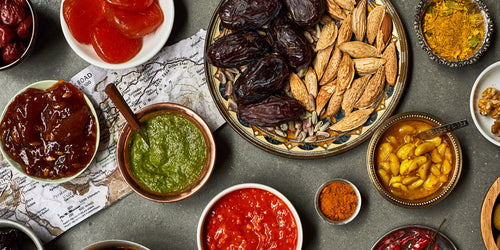Your Cart is Empty
I have been lucky to experience the food of Bangladesh and West Bengal both at home and in restaurants like Boishakhi in Queens, Korai Kitchen in Jersey City, and Kabir’s Bakery in Brooklyn. This is because my partner hails from Dhaka, the capital of Bangladesh, which won its independence from Pakistan in 1971. And yet since Bangladesh is still a young nation, there isn’t a widespread understanding of or demand for its food—which layers a brilliant array of spices from turmeric to cumin seeds, the pungent aroma of mustard oil, and the heat of chiles with fresh fish and vegetables—amongst Westerners. Most people aren’t familiar with delicious dishes like phuchka (the Bengali answer to panipuri) or hilsa fried fish— and that needs to change. The good news is that all you need to get acquainted with the region’s uniquely flavorful cooking are a handful of pantry staples and some recipes. We tapped two experts to help guide you.

Image from MY BANGLADESH KITCHEN by Saira Hamilton, published by Lorenz Books.
Although a sizable portion of the Bengal diaspora lives in the United States (most significantly New York and New Jersey), the UK, Canada, and Australia, the cuisine is vastly underrepresented in restaurants and English-language cookbooks. This was one of the reasons that Saira Hamilton, a MasterChef UK finalist, decided to pen her award-winning cookbook My Bangladesh Kitchen. “There’s a big culture of Indian restaurants, particularly in the south and east of England in London, where you’re ‘going for a curry’ or ‘going for an Indian,’” she says, “But most of the restaurants are owned by Bangladeshis, and none of them cook Bangladeshi food, they do Anglicized Indian food.” Her cookbook is a deep dive into Bangladeshi cuisine and how it’s different from those of India.


Images from MY BANGLADESH KITCHEN by Saira Hamilton, published by Lorenz Books.
Saptarshi Chakraborty and his wife Insiya Poonawala had a similar motivation for launching their popular YouTube channel Bong Eats, which documents the food of Calcutta. “We realized that outside of Bengal, very little is known or understood about our cuisine,” Chakraborty says, adding that it’s largely because Bengalis are very protective of their culture. And yet the couple felt that more people should be informed about, and be able to cook, delicious Bengali dishes.

Image from Bong Eats.
The differences between Bangladeshi and Bengali food are slight but notable. While onion and garlic are used heavily in (Muslim) Bangladeshi dishes, Hindu Bengalis shy away from them as they are considered “tamasic,” which means they have a sedative effect on the body and mind. There are also distinctions between the order in which dishes are presented in a standard meal. In Calcutta, you start with a stir-fry of bitters (such as bitter gourd or neem leaves, depending on the season) followed by dal and vegetables, then a fish course, and finish with a sweet-savory chutney. Rice is provided at the start of any meal, which is also true in Dhaka, where dal comes last, and curries are often served after fish.
What follows is a primer on everyday Bangladeshi and Bengali food, broken down by key ingredients of the Bengal pantry.

Image from Bong Eats.
Mustard Oil, Seeds, and Condiments
“Mustard oil is the predominant flavor,” Hamilton says. Most Bangladeshi or Bengali dishes, and especially curries, start with mustard oil, which imparts a pungent, sharp, and clean flavor. Chakraborty says that he’ll use mustard oil even in a simple omelet for breakfast.
Mustard oil is hard to find in the U.S., EU, and Canada, due to the presence of erucic acid, which some (questionable) studies have linked to increased risk of heart disease when consumed at high levels. However, it's easy to make your own by infusing vegetable oil with freshly crushed mustard seeds. Hamilton recommends adding a teaspoon of mustard oil at the final stage of curry as well, to “brighten all the flavors.”
Kasundi is the Bangla word for hot mustard-based sauces and relishes—the most popular condiment in Bengali cuisine. Chakraborty defines it as “different kinds of pickles, which are made in summer, some use green mango, others use other vegetables, but it’s basically a very hot raw mustard paste.”
Panch Phoran
Panch Phoran, which translates to “five spices,” is a mix of fenugreek seeds, nigella seeds, cumin seeds, black mustard seeds, and fennel seeds. The blend serves as the foundation for much of Bengali and Bangladeshi cuisine.
As Chakraborty notes, “undivided Bengal is a very riverine, fertile place,” so everyday food is mostly comprised of leafy vegetables and freshwater fish, plus panch phoran. For him, the “high point of Bengali cuisine” is infusing mustard oil with panch phoran and using it to cook vegetables. “There are no extra spices, apart from turmeric and salt, it’s just gently cooking the vegetables until you take them to a place where the flavors melt together, but you can still taste them separately,” he says.
Hamilton agrees: “you put a little bit of [panch phoran] on some fried fish or whatever, and it instantly tastes Bangladeshi to me.”

Image from MY BANGLADESH KITCHEN by Saira Hamilton, published by Lorenz Books.
Turmeric
As is the case with many Indian cuisines, turmeric is a go-to ingredient in Bangladeshi and Bengali cooking. The bright orange-yellow spice is used in powder form to season everything from snacks to curries and sometimes as a paste prepared from the fresh root.
“A lot of our dishes are not long marinades or slow cooks,” Hamilton says, “It’s a lot of super quick [preparations], a bit of turmeric and chile on a fish, then fried and eaten. So you retain a lot of freshness of the flavors.”
Lentils
Dal, which refers to lentils themselves as well as the soupy dish made from simmering them, is a staple of every meal. Masoor dal (red split lentils) is the most popular, and Hamilton recommends her tarka dal recipe or “lentils simmered in garlic” as an exemplary entry point into Bangladeshi cuisine. Moong dal (yellow split mung beans) are common as well, and chana dal (split brown chickpeas) are used to make heartier dals for festive occasions.
Chiles
Bangladeshis and Bengalis love spice and the usual source is fresh green chiles. The skinny peppers are served as raw garnishes alongside meals and sliced in half or kept whole to infuse dishes. But chile powder is important as well, in addition to dried chiles, which can be crushed and then used as a seasoning or spice. In her book, Hamilton writes that Kashmiri chiles “are the most prized, for their bright colour and milder heat level.” You can buy them whole or powdered.
Radhuni
Radhuni seeds are a uniquely Bengali ingredient, grown locally and used rarely in other cuisines. They are very difficult to find outside of Bengal and are oftentimes compared to celery seeds, although the two are different plants. Radhuni seeds can be incorporated into panch phoran in place of cumin seeds, such as in this Bong Eats recipe. They’re also used for pickling.

In addition to these essential ingredients, anyone who is interested in cooking Bangladeshi and Bengali food should stock the more standard spices of ground coriander, cumin powder, whole cloves, cinnamon (or the rarer cassia bark), and as a bonus, cardamom pods. It’s also important to have limes (to squeeze on top of final dishes), plenty of white rice (ideally basmati), plus onions for Bangladeshi preparations. And you’d be smart to buy a copy of Saira Hamilton’s My Bangladesh Kitchen and subscribe to Bong Eats. With all or most of these tools and flavors, your journey to discovering one of the world’s most underrated cuisines can begin.









